Graphic Novels: Black, White, and Shades of Gray
Good versus evil, hero versus villain, right versus wrong. Sometimes morality is a code of black and white, other times a gray area can be found. Wherever your moral compass code points, you’ll be able to find a graphic novel in these five reviewed in our July/August 2017 issue.
Wonder Woman
Volume 2: Year One
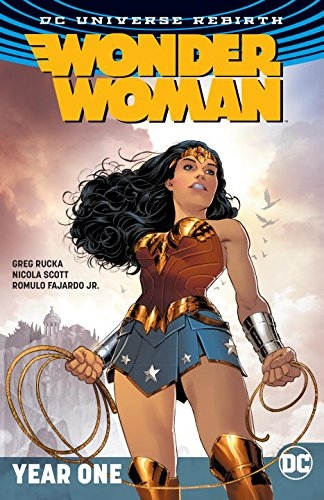
Greg Rucka
Nicola Scott, illustrator
Romulo Fajardo Jr., illustrator
DC Comics
Softcover $16.99 (168pp)
978-1-4012-6880-0
Greg Rucka, Nicola Scott, and Romulo Fajardo Jr. lay out a thoroughly enjoyable origin story for one of DC’s most famous characters, in their exciting and endearing graphic novel Wonder Woman: Year One.
Wonder Woman, despite being perhaps the single most recognizable female superhero ever created, has always suffered from the lack of a definitive, memorable origin story. Where Batman had his parents’ murder in Crime Alley, and Superman was sent to Earth from a crumbling planet Krypton, many conflicting versions of Wonder Woman’s origin were created during the seventy-six years the character has been in print.
Wonder Woman: Year One collects issues 2, 4, 6, 8 ,10, 12, and 14 from the monthly DC Universe Rebirth series Wonder Woman, which alternated between a “present-day” story line (collected in Wonder Woman Vol. One: The Lies) and the new origin story.
Rucka’s script and Scott’s art shine in equal measure, introducing Diana as a young woman, chosen as her people’s champion to travel from her home island of Themyscira. Year One reintroduces longtime Wonder Woman characters like Steve Trevor and Etta Candy, but most notable is the appealing portrayal of Diana as she becomes Wonder Woman—a capable figure, yet somewhat innocent and idealistic in her understanding of the wider world.
Diana is visited by “the patrons”—“Gray-eyed Athena and proud Hera and cunning Artemis”—in their animal forms. These creatures are described as providing her “gifts”—her super powers. But unlike in earlier tales, Diana’s culture is no longer described as strictly the product of Greek myth; Barbara Ann Minerva, an archaeologist destined to become Cheetah, one of Wonder Woman’s greatest nemeses, says of the Amazon language, “It’s an amalgam dialect. Greco-Slavic, but there’s an Afro-Asiatic presence.” This slant opens new possibilities for an origin story set in the twenty-first century, allowing the believable use of characters from diverse backgrounds—Themyscira’s all-female population boasts a wide variety of hair and skin colors, more representative of modern-day readership.
A character who’s been around such a long time can be intimidating to new readers—the question of what to read first is common. Wonder Woman: Year One provides an answer: this.
PETER DABBENE (June 28, 2017)
Allen, Son of Hellcock
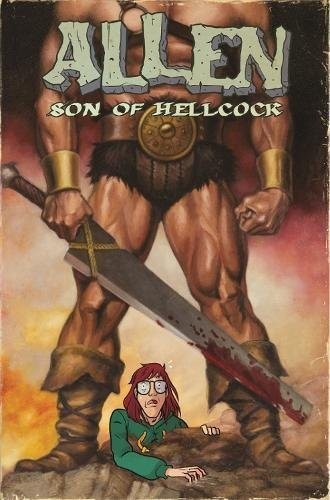
Will Tracy
Gabe Koplowitz
Miguel Porto, illustrator
Z2 Comics
Hardcover $21.99 (136pp)
978-1-940878-08-9
Allen, Son of Hellcock is an amusing and entertaining romp that satirizes Conan-type fantasy tales while also posing the question, how does a son live up to a father who’s become a legend?
Tongue-in-cheek throughout, Allen, Son of Hellcock focuses on Allen, the meek and mild progeny of the fabled (and deceased) swordsman Hellcock. Hellcock is now a ghost, and in his absence, Allen is sucked into a battle with Kaarl, the son of Hellcock’s former archenemy, Lord Krong. Enlisting the surviving members of Hellcock’s band of heroes and aided by Madeline, an aggressive leader who also serves as Allen’s romantic interest, the Son of Hellcock heads for a decisive encounter with Kaarl’s forces.
Koplowitz and Tracy infuse the entire book with a sense of fun, and it’s abundantly evident that they enjoyed the experience of writing it. They break the fourth wall at times and introduce numerous sight gags—delivered with style and aplomb by artists Porto and Wells—including recurring appearances of bizarrely intriguing horse-donkey hybrids.
The writers also have a knack for bestowing their characters with funny names—the supporting cast includes Grumbus, Skrell the Gloomorian, Prince Bolderon, and Xerxax of New Champia, just to name a few. These characters embody the most ridiculous aspects of fantasy heroes, and there’s a steady stream of laughs as they accompany Allen on his quest to defeat Kaarl.
There’s also plenty of humor to be had mining the nature of celebrity and fandom, as Allen witnesses the 25th annual Hellcockcon fan gathering, where dealers sell “Hellcock Grog Koozies” and “Hellcock Unlicensed Erotic Fan Fiction,” and in exploring the thorny relationships of Allen and Hellcock, and Kaarl and Lord Krong—sons who live in shadows of their famous fathers while attempting to forge their own paths.
Allen, Son of Hellcock will be of particular interest to fans of swords and sorcery who are looking for a lighthearted take on the subject, but the book is so well conceived and executed that even those unfamiliar with the trappings of the genre with find themselves chuckling aloud.
PETER DABBENE (June 28, 2017)
Trespasser
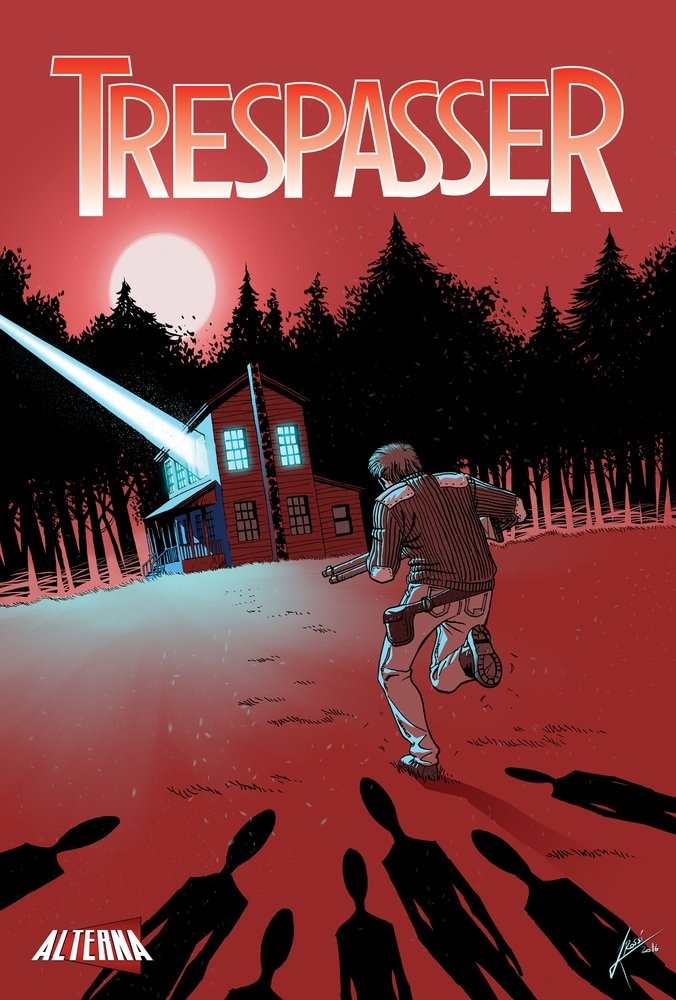
Justin M. Ryan
Kristian Rossi, illustrator
D. C. Hopkins, illustrator
Alterna
Softcover $9.95 (96pp)
978-1-945762-04-8
In Trespasser, Justin M. Ryan presents the suspenseful tale of a man and his daughter who are living in a postapocalyptic wilderness, and meet an alien and deal with the consequences of that encounter.
Except for one brief exception, Trespasser is set in and around a single house in the woods, distanced from human contact because of some unnamed past cataclysm and the stubbornness of its owner, Hector Ramos, who lives alone with his daughter, Maria, and their dog, Belle. Nuclear war—or some other event leaving behind the scars of radioactivity—has left traces of dystopia everywhere, from their dog, who bears a vestigial third set of paws, to the Geiger counter that indicates whether the mutated animals in the area are safe for consumption.
Hector and Maria’s lives are irrevocably altered when an alien is caught in one of Hector’s animal traps and brought back to the house to recover. Unable to communicate with the alien, Hector quickly grows distrustful and embarks on a course that puts him, and his daughter, in grave danger.
Taut and claustrophobic, Trespasser wields the dark energy of noir, mixed with the lively imagination of science fiction. Ryan’s writing is outstanding, giving insight into Hector’s motivations, but also knowing when to pull back and leave something unexplained. This is the strength of the story—is the alien a threat, or not? Is Hector behaving rationally, or has he become paranoid in his isolation? The story demands a one-sitting read, but perhaps more impressive is the way the carefully posed, but unresolved, questions linger in the brain once the cover is closed.
Rossi and Hopkins’s art is impeccable, with beautiful line work balanced by moody inks and spot-on color choices that enhance the tense tone throughout the book. Composition stands out, as well—the panels flow organically, and show an understanding of when to fill a background with telling details and when to let the page “breathe” with open space.
Trespasser is a shining example of a seemingly simple, stand-alone story that provides not just compelling entertainment but also substantial food for thought.
PETER DABBENE (June 28, 2017)
Close Enough for the Angels
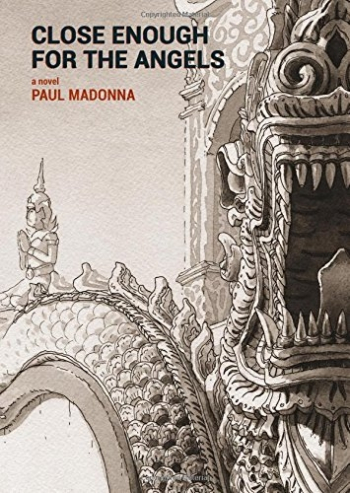
Paul Maddona
Petty Curse Books
Hardcover $34.99 (440pp)
978-1-5132-6081-5
Close Enough for the Angels follows Emit Hopper, a former rock star, writer, and artist, along a twisting path to peace and self-discovery.
Close Enough for the Angels is mostly prose, but it features illustrations throughout—over one hundred in total. They’re not on every page, and sometimes they come in bursts of several at a time; the format is reminiscent of Brian Selznick’s, author of The Houdini Box and The Invention of Hugo Cabret, among other books—but Madonna’s work stands as uniquely his own.
Madonna’s ink-on-paper illustrations tend toward striking landscape and city scenes from Thailand, Japan, and China—all locations featured prominently in the story—but their true purpose, along with the fictional origin of the book itself, is revealed only near the end. Madonna’s prose, meanwhile, is magnificent as he tells the story of Emit Hopper, a man who finds himself experiencing repeating themes in his life.
Told in three alternating, expertly interwoven sequences, the book traces Emit’s first travels in Thailand, his early life and marriage, and his later life as an artist. Mysteries abound—some are ultimately revealed, others left tantalizingly unresolved.
Plenty of philosophical ideas are addressed throughout the book, but Madonna isn’t heavy-handed about it; many aspects are integral to the events of Emit’s or the other characters’ lives. The idea of dying and creating a new incarnation of oneself is seen in Emit’s changing his name, faking his own death, and in the many reinventions of himself—the same with his love interest, Julia Marie Rose, a former restauranteur and frozen-dinner magnate. The theme of repetition and the circular nature of life is noted by Emit: “It was as if, now that I had seen that life was nothing but a series of repetitions, a dam had burst, and one after another, every event, every thought, every thing was coming back.”
Close Enough for the Angels is a deeply satisfying, ruminative meditation on life seen through the eyes of appealing, but imperfect, characters—it is highly recommended.
PETER DABBENE (June 28, 2017)
Angel City
Town Without Pity
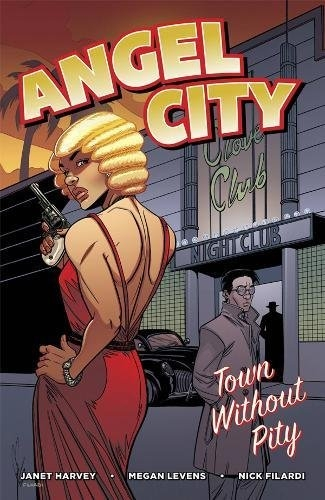
Janet Harvey
Megan Levens, illustrator
Nick Filardi, illustrator
Oni Press
Softcover $19.99 (168pp)
978-1-62010-426-2
Angel City: Town Without Pity takes 1930s noir style, sets the story in Hollywood, and makes one major change from similar tales—here, a woman is the hero.
Dolores Dare, a former circus performer and aspiring actress, now working as a mob enforcer, is dragged into a mystery when her best friend, Frances Faye, is mysteriously killed.
A murder to be solved, mob involvement, and Hollywood studios that might be complicit are not new subjects for fiction, but Harvey brings distinct elements to the fore, simply by looking through the lens of a woman protagonist. Dare—formerly Dorothy Dunkel—is a survivor, but with a different set of talents and circumstances than other (male) noir protagonists. Adding to the interest is the role of her right-hand man, a Japanese-American journalist named Joe Yoshimoto.
Without a trench-coated, hard-boiled detective to solve the murder, it’s up to Dolores to untangle the web of greed and crime that snared her friend, and threatens to do the same to her.
Despite clever vérité touches like convincingly weaving real-life gangster Bugsy Siegel and a mention of publisher William Randolph Hearst into the story, the real treat here is getting the perspective of Dolores and Joe, a pair who represent the often-ignored background figures in many noir stories, now cast in leading roles.
Harvey’s ear for dialogue is excellent, using 1930s slang like “rubes,” “holy smokes,” and “dollface” without overdoing it. Levens does a great job depicting Los Angeles during the Golden Age of Hollywood—hair and clothing, as well as architecture, all ring true—but she has a distracting habit of drawing short horizontal lines across the bridge of her characters’ noses. Few escape this treatment, whether male or female, of varying age or ethnicity, and it immediately draws the eye, slightly diminishing the luster of Levens’s otherwise outstanding art.
Harvey, who has worked in film and television in addition to comics, has created a story that would make a good movie; however, with a woman as the main character, the chances of that happening aren’t good. Noir fans can take heart that Angel City: Town Without Pity exists to give a moody and compelling story the treatment it deserves.
PETER DABBENE (June 28, 2017)
Peter Dabbene

